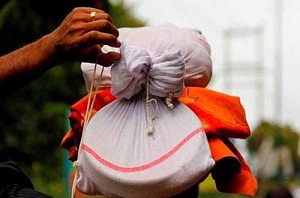Special pandals are used for the ritual, where fire is set with camphor and wood. The devotees chant “Swamiye Sharanam Ayyappa” and circumambulate the fire and throw rice and coconut pieces, as the flames rise higher. While the flames are symbolic of Lord Ayyappan Swamy, the items thrown in the fire indicate the worldly desires which is destroyed by the Swamy who is the embodiment of true wisdom.
Kettunira
 An important aspect of Sabarimala pilgrimage is the Irumudi Kettu also known as Kettumuruku. Devotees visiting the shrine are not allowed to climb the 18 steps at the Sannidhanam without the Irumudi. Irumudi symbolizes Lord Ayyappan’s journey to the jungle to procure the tigress’ milk. The bag has twin compartments – Munmudi (front pouch) and Pinmudi (rear pouch) along with one more opening in the middle. The front pouch holds items of offering at the Sannidhanam. Articles of the devotee’s personal use are kept in the rear pouch which are required to use from day of commencement of the journey to Sannidhanam till return. The devotee takes a second bag that contains snacks, pulses and other food items that are prepared during the journey. The Guruswami (Guruswamy is one who has undertaken 18 or more pilgrimages and climbed the Pathinettam Padi eighteen times) prepares the Irmudikettu and places on the head of the pilgrim.
An important aspect of Sabarimala pilgrimage is the Irumudi Kettu also known as Kettumuruku. Devotees visiting the shrine are not allowed to climb the 18 steps at the Sannidhanam without the Irumudi. Irumudi symbolizes Lord Ayyappan’s journey to the jungle to procure the tigress’ milk. The bag has twin compartments – Munmudi (front pouch) and Pinmudi (rear pouch) along with one more opening in the middle. The front pouch holds items of offering at the Sannidhanam. Articles of the devotee’s personal use are kept in the rear pouch which are required to use from day of commencement of the journey to Sannidhanam till return. The devotee takes a second bag that contains snacks, pulses and other food items that are prepared during the journey. The Guruswami (Guruswamy is one who has undertaken 18 or more pilgrimages and climbed the Pathinettam Padi eighteen times) prepares the Irmudikettu and places on the head of the pilgrim.
Devotees go in groups to Sabarimala. The traditional route to the shrine is Erumeli, Kalaketti, Azhutha, Karimala, Pampa and eventually Sabarimala.






